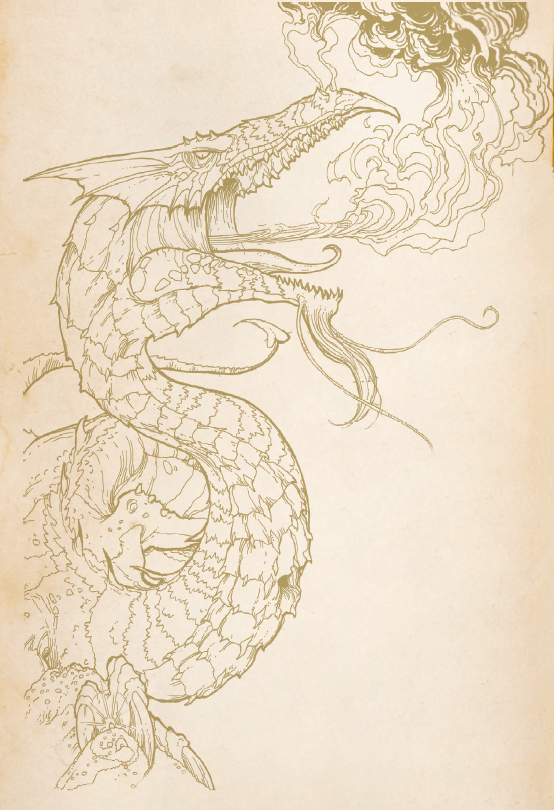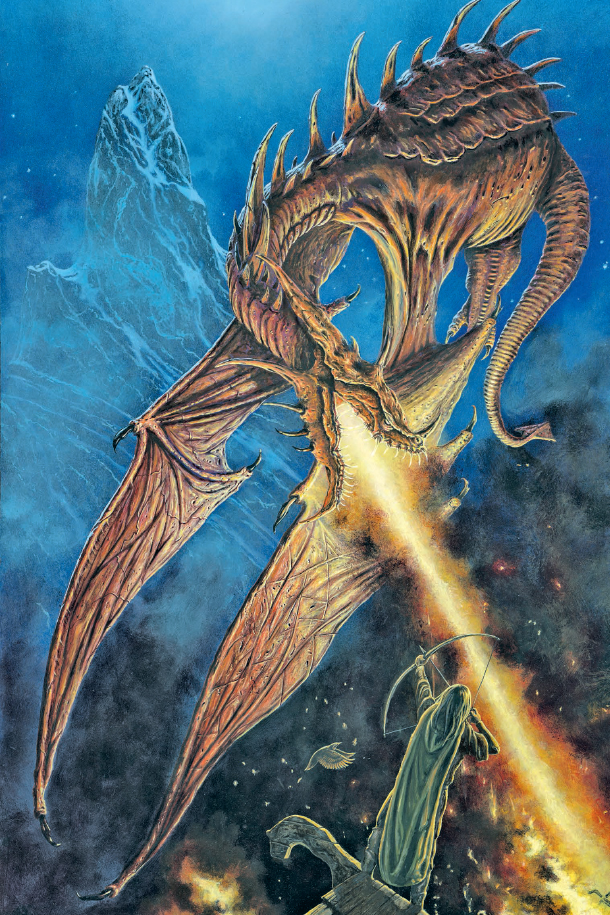SMAUG, THE GOLDEN DRAGON OF EREBOR

“A dragon is no idle fancy,” Tolkien once observed. “Whatever may be his origins, in fact or invention, the dragon in legend is a potent creation of men’s imagination, richer in significance than his barrow is in gold.” In the author’s view, this truly wonderful monster has such universal appeal that “Everyman” in every age may find himself or herself “caught by the fascination of the worm”.

Smaug the Golden
Tolkien was one who searched for “dragons, real dragons, essential both to the machinery and the ideas of a poem or tale”. He found them in Germanic literature and mythology, but also, very specifically, through the writing of his fairy-tale story of The Hobbit, in the Anglo-Saxon poem Beowulf.
The Hobbit takes its basic plotline from Beowulf’s fatal encounter with a dragon. In that ancient poem, a thief enters the dragon’s lair and steals a gold cup. In Tolkien’s tale, the thief is the Hobbit, Bilbo Baggins. And, in both tales, the theft of a gold cup awakens a sleeping dragon that emerges from its lair to lay waste to a nearby kingdom. The Hobbit is essentially the Beowulf dragon story told from the thief’s point of view. There is, however, one problem with Beowulf’s dragon. He is more the terrifying embodiment of an evil curse than an individual villain who happens to be a dragon.
All characters in a really good fairy-tale adventure must give the listener or reader a close-up, intimate feeling. This is true of all of an adventure’s characters, even – or especially – the villainous ones. The trouble with the Beowulf dragon is that the closer you come to him in the story, the more he recedes. You cannot gain a hold on him: the monster is not even given a name.
For Tolkien, this was a cardinal sin. Within the legendarium of Middle-earth, names are all-important, providing the essential nature of every life form, both generic and individual. Tolkien began to feel like the maiden in “Rumpelstiltskin”, whose fate depended on discovering the creature’s true name. With this end in mind, and via a philological search through a treasure trove of Old English and Proto-Germanic words, Tolkien arrived at the name “Smaug”.
Smaug the Golden, Smaug the Magnificent, Lord Smaug the Impenetrable. Smaug, Tolkien decided, was going to be the name of the greatest Dragon of the Third Age. Not simply a Cold-drake like those of the Grey Mountains, Smaug is a full-fledged golden-red Fire-drake, with vast batlike wings and a coat of impenetrable iron scales. Far better than a large but nameless lizard like Beowulf’s monster, Smaug, the Greatest of Calamities, carries the collective meaning of his name’s composite parts in Old English: penetrating, inquiring, burrowing, worming into, creeping through. These are all useful clues to a really slippery, intelligent and nasty villain. Then, too, comes an appropriate – if accidental – pun on the word “smog”, which insinuates its way through like a distinctive whiff of brimstone.
To all the sinister qualities gained by way of the naming of Smaug, Tolkien added a multitude of aspects derived from legendary dragons dating back to the ancient Greek Python of Delphi in their role as fierce guardians of treasure: a great serpent; a keeper of arcane knowledge; a monster with an inquiring mind, a terrifying glance and a mesmerizing voice. It is certain that from this hoard of dragon lore, Smaug the Worm of Dread inherited his laser eyes, brilliant intellect, mesmerizing spells, and a few of his other more terrifying qualities.

Tolkien’s childhood “Green Great Dragon”
And yet, as Tolkien famously wrote in his lecture “On Fairy-Stories”: “The dragon had the trade-mark of Faerie written plain upon him.” This is perhaps why his dragons appear either in the ancient mythic world of Elves in The Silmarillion or in the children’s fairy-tale world of Hobbits in The Hobbit, but not in the epic high romance world of mortal Men in The Lord of the Rings.
In the creation of Smaug the Golden, we see the perfect fairy-tale dragon: a villain of great charm, intelligence and fatal vanity. A flying, fire-breathing dragon, whose terrible wrath and vengeance is somehow still admired as one might observe a truly spectacular fireworks display. The reason for this is the playful nature of such creatures in true fairy tales, where one knows that the flying terror, no matter how fearful, will be overcome and that nearly every really good person (or Hobbit) is guaranteed a happy ending.
And so it is that, betrayed by his own vanity, Smaug the Smug is outwitted by a humble Hobbit – and then ultimately slain by the courageous Bard the Bowman.

Bard the Bowman slays Smaug the Golden